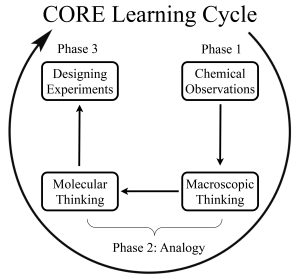General Chemistry – Analogical Reasoning in Lab
Chemistry can be very abstract. It’s impossible to directly observe phenomena at the molecular and atomic level. Thinking about chemistry with analogies can help us make connections between tangible, everyday, real-world phenomena and the often abstract, invisible processes that occur in a chemistry lab.
What is an analogy?
An analogy is a comparison between two domains, the analog concept (or source) that is familiar, and a target concept, which may be new or unfamiliar. Common examples of analogies used in science include: DNA (target) is like a ladder (analog), a kidney (target) is like a waste filter (analog), and the eye (target) is like a camera (analog).
Why use analogies in science?
The purpose of using an analogy is to give you insight into the chemistry involved in the lab experiment that is invisible. Thinking about chemistry at the molecular level is not trivial. Even if you are already familiar with the chemical concepts under investigation, thinking about an analogy or a model of a chemical concept can help deepen your understanding. Many famous scientists (even Albert Einstein) have reported using analogical thinking to come up with predictions and explanations about abstract scientific phenomena in order to make sense of theoretical and experimental results.
Papers published on analogical reasoning at UMaine.
Shirly Avargil, Mitchell R. M. Bruce, François G. Amar, and Alice E. Bruce, “Students’ Understanding of Analogy after a CORE (Chemical Observations, Representations, Experimentation) Learning Cycle, General Chemistry Experiment“, J. Chem. Ed. Articles ASAP (As Soon As Publishable) Publication Date (Web): August 13, 2015 (Chemical Education Research) DOI: 10.1021/acs.jchemed.5b00230

